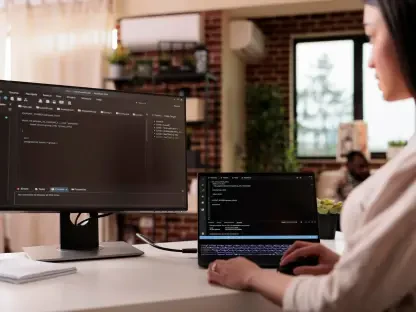OpenAI’s recent introduction of the SWE-Lancer benchmark has sparked a significant conversation about the role of AI in software engineering. This pioneering benchmark measures AI’s performance in real-world software engineering tasks, particularly in comparison to human freelancers. The findings reveal both the strengths and limitations of AI in this field, highlighting the current state of AI capabilities and the areas where human expertise remains indispensable.
AI’s Strengths in Software Engineering
Proficiency in Structured Programming
AI models have shown remarkable proficiency in structured programming tasks. Tools like GitHub Copilot can generate functional code snippets efficiently, often streamlining the coding process for developers. This capability is particularly useful for tasks that involve well-defined constraints and repetitive coding patterns. By automating these elements, AI helps developers save time, enabling them to focus on more complex aspects of their projects. However, this proficiency is limited to scenarios where the logic and requirements of the task are well established and clearly defined.
In addition, AI tools adeptly handle straightforward syntax corrections, adhering to specified rules and standards without much deviation. AI excels at this kind of work because it leverages extensive databases containing vast amounts of code examples and best practices. This massive repository of structured programming knowledge allows AI to produce accurate and functional code snippets rapidly. Despite these strengths, larger-scale applications still require substantial human oversight to ensure coherence across the entire software architecture.
Speed in Localizing Issues
One of the standout strengths of AI in software engineering is its ability to quickly localize issues through keyword searches across code repositories. This speed advantage is a significant asset, allowing AI tools to identify potential problems faster than human developers, which can expedite the initial stages of debugging. By scanning vast amounts of code in a short period of time, AI reduces the time developers spend sifting through lines of code to find errors. This efficiency allows human developers to allocate more time to other critical tasks such as system design, user experience improvements, and more complex debugging efforts.
AI’s proficiency at quickly identifying potential issues arises from its advanced algorithms and machine learning models that detect patterns and anomalies in code efficiently. These capabilities are particularly beneficial in large codebases where tracking down a bug may otherwise take considerable time. Despite this, it’s important to consider that AI’s strength in speed does not directly translate to solving the issues. The ultimate resolution of identified issues still largely depends on human developers’ expertise in understanding business logic and context, which AI currently lacks.
Limitations in Debugging
Struggles with Complex Issues
Despite their speed, AI tools exhibit notable limitations when it comes to comprehending and resolving complex issues that span multiple components or files. This lack of deep understanding often results in partial or flawed solutions, as AI models struggle to address the root causes of problems effectively. AI’s inability to grasp the bigger picture can lead to missing important interdependencies between different parts of the software system, causing inadequate troubleshooting results. Complex debugging often requires a comprehensive understanding of the software components and their intricate relationships, a domain where human cognitive abilities outshine machine pattern recognition.
Additionally, AI’s limitations become particularly evident when dealing with legacy systems or code that has evolved organically over time. These systems often contain convoluted logic and undocumented features, which AI tools find challenging to interpret correctly. AI models primarily rely on previously encountered patterns, and when faced with unfamiliar or unstructured code, their effectiveness plummets. Therefore, in environments where the code is highly customized or involves convoluted implementation details, human developers’ expertise remains critical to ensuring accurate and efficient debugging.
Dependence on Pattern Recognition
Current AI models predominantly rely on pattern recognition, making them adept at syntax correction but unreliable for ambiguous debugging tasks. This dependency limits their ability to troubleshoot and resolve logical flaws in code, necessitating significant human intervention to ensure reliable outcomes. AI’s pattern-recognition-driven approach is particularly vulnerable to edge cases where errors do not conform to recognized patterns. In such scenarios, AI tools may fail to identify or incorrectly diagnose the issues, further complicating the debugging process. The human ability to apply contextual knowledge and creative problem-solving techniques is indispensable in overcoming these limitations.
Moreover, AI’s reliance on pattern recognition undermines its capability to handle scenarios requiring intuition and experiential insights, which are critical aspects of sophisticated debugging. Unlike humans, AI lacks the capacity to foresee the broader implications of a change or modification made to the code. Human engineers, on the other hand, can foresee potential cascading effects based on their experience and understanding of the system. Consequently, the current state of AI restricts its ability to autonomously navigate complex debugging tasks, underscoring the need for proficient human oversight in ensuring robust and functional software development.
Impact on the Freelance Job Market
Decline in Routine Coding Tasks
The adoption of AI-based automation by businesses has led to a noticeable decline in freelance work for routine coding tasks. Studies indicate a 21% decrease in freelance opportunities in software development and writing, as AI tools take over these simpler tasks. This shift reflects the increasing proficiency of AI in handling repetitive and well-defined coding assignments, diminishing the need for human involvement in these tasks. As companies embrace AI to streamline their operations, the job market has seen a redistribution of roles where the demand for routine coders is waning.
Interestingly, the impact of AI on the freelance market is also seen in businesses’ preference for cost-effective solutions. AI automation can substantially reduce expenses linked to hiring multiple freelancers for basic coding tasks. However, this decline in routine opportunities does not translate to a complete loss of freelance jobs. Instead, it signifies a transformation in the market dynamics where freelancers are now tasked with more intricate, value-adding roles that machines cannot yet effectively undertake.
Shift to Higher-Level Problem-Solving
As AI handles more routine coding, the demand for freelancers has shifted towards roles that emphasize higher-level problem-solving, debugging, validation, and optimization of AI-generated outputs. This evolution reflects the changing landscape of software engineering, where managing AI-assisted development has become a crucial skill. Freelancers are now required to possess a deeper understanding of AI mechanisms and the ability to refine AI-generated code to ensure quality and functionality. This shift indicates a nuanced role where human expertise complements AI capabilities to achieve superior outcomes.
Furthermore, another emerging trend is the increased emphasis on strategic insights and system-level thinking. As AI assumes responsibility for basic coding, freelancers are moving towards consultancy and advisory capacities where their input drives the architectural and strategic decisions of software projects. The freelance job market is thus evolving, with a notable demand for software engineers who can effectively leverage AI tools and address sophisticated challenges. This transformation underscores the importance of continuous learning and upskilling for freelancers to remain relevant in the AI-augmented landscape.
The Future of AI in Software Engineering
Ongoing Efforts to Improve AI Capabilities
Efforts are ongoing to enhance AI’s capabilities in software engineering, particularly in debugging. Companies like Cognition are developing AI models, such as Devin, that aim to independently code and debug applications. If successful, these advancements could revolutionize software engineering workflows. By integrating AI systems that can autonomously manage more complex debugging tasks, the industry may witness a gradual reduction in the dependency on human intervention. However, achieving this milestone necessitates breakthroughs in AI’s comprehension and reasoning abilities.
The progress in improving AI capabilities largely hinges on developing sophisticated algorithms capable of understanding context and logical dependencies within code. Researchers are exploring techniques that combine machine learning with symbolic reasoning to bridge this gap. Additionally, incorporating advanced neural networks that mimic human cognitive processes could significantly bolster AI’s performance in tackling ambiguous and multifaceted debugging challenges. Should these innovations bear fruit, the potential for AI to transform software engineering practices and augment the productivity of development teams is immense.
The Need for Human Oversight
OpenAI’s introduction of the SWE-Lancer benchmark has ignited a substantial dialogue about the evolving role of artificial intelligence in software engineering. This groundbreaking benchmark is designed to assess AI’s effectiveness in handling real-world software engineering tasks and directly compare its performance to that of human freelancers. The insights gathered from this benchmark shed light on both the strengths and weaknesses of AI within this field. The results underscore the current state of AI capabilities while also pointing out the critical areas where human expertise remains essential and irreplaceable. As AI continues to advance, these findings highlight the importance of collaboration between human professionals and AI, ensuring that both can complement each other effectively. The conversation around SWE-Lancer is not just about noting AI’s progress, but also about recognizing the indispensable qualities that human software engineers bring to the table, which AI has not yet mastered. This will ultimately shape the future of AI integration in the software engineering industry.









